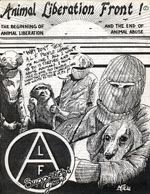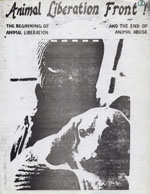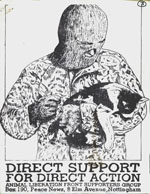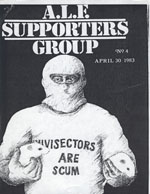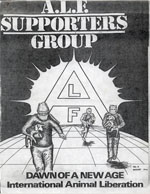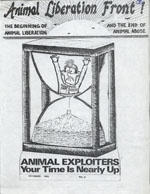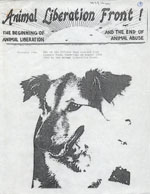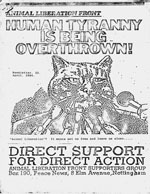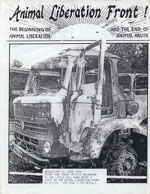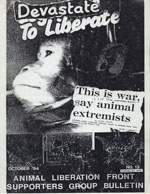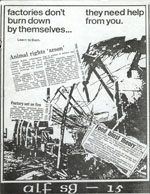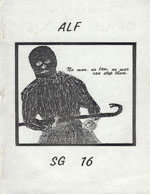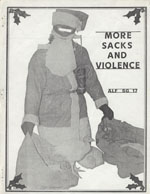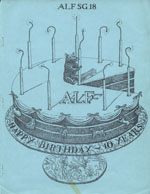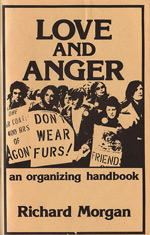The Archives
-
Periodicals, The Beast
The Beast – rare supplemental issues.
07.01.13 | PermalinkThe Beast Supplements 1 & 2 (1978? London, England)
Before The Beast became our movements first great newstand magazine, two editions were produced as a supplement for the International Times newspaper.
Targeting the information inside to a wide variety of “animal protection” ideologies, The Beast quickly drew the attention of people ranging from old school anti-vivisectionists to environmentalists. This new readership included people like McLibel defendant Dave Morris, Animal Liberation Front co-founder Ronnie Lee, and open rescue pioneer Pattie Mark. By the time the full size magazine had an existence independent from the International Times, foreign correspondents were already on board and writing about the emerging movement for animal liberation taking place globally.
We are seeking more stories from those inspired by, or working for The Beast in the late 1970s and early 1980s. If you have a tale to tell please contact us HERE.
…
-
Most Popular, Periodicals, The SG (original 80s volume)
The ALF Supporters Group Newsletter – The complete original set!
03.04.13 | PermalinkThe ALF Supporters Group Newsletter #1-19 (1982-1986. Nottingham / London, England)
When this archive project was founded two years ago, a list was made of the ten publications that we “had to have.” Number one was a complete set of the first volume of “The SG.” This was a tall order, and we knew it. First off, the Animal Liberation Front Supporters Group must be one of the most raided entities in England, and its members were frequently raided themselves! The result was that many copies of the magazine ended up in police custody both before and after distribution, never to be seen again. Second, it was a relatively old newsletter, and since the first issues were mimeographed on cheap paper, finding intact copies was going to be difficult. We persevered though, and now these rare pieces of movement history are preserved digitally and online for everyone to read and learn from.
Started by Dave Nicholls in 1982, the ALF Supporters Group was an effort to do two things: 1.) To raise funds for people arrested for animal related direct actions. 2.) To create a broader base of support for the Animal Liberation Front inside the movement. Both goals were met quickly. Within two weeks of their founding, the Supporters Group hit the number of members they had set as their long term goal. Through direct donations, memberships, fundraising events, and sales of merchandise, the SG was able to contribute towards the sizable legal costs of activists being arrested across England.
The newsletter itself went through varying degrees of quality in writing, layout, and value to the movement. The early days of the Nicholls run may have had a drab interior, but the hand illustrated covers were sometimes gorgeous, and the rhetoric had not yet strayed into the more-militant-than-thou nonsense which came later. Eventually the writing would border on the cultish, but there is scarcely an issue of the magazine that doesn’t have some redeeming value. When read critically and as a whole body of work, this magazine follows the rise and spread of underground action for animals across the globe, illustrates the value of coalition building, and provides solid examples of extremism to be avoided through coverage of groups like the Animal Rights Militia. It also provides many historical details found nowhere else!
“The SG” has gone through several incarnations since British Law enforcement shut this one down in 1986. (While carrying out the investigation for the notorious Sheffield trial that sent Ronnie Lee to prison for 10 years, the police raided the SG and charged it’s editors with incitement. Everything published by the SG afterwords had to be run past a lawyer first, but this didn’t stop further raids, arrests, and convictions of those involved in the newsletter.) It is still being published today, copies can be ordered from www.alfsg.org.uk.
Finally, an excellent analysis and critique of the SG and the rise of England’s “Cult of Militancy” can be found in the book Against All Odds, available here at the Talon Conspiracy.
…
-
Books
The raw stuff of history: An incomplete, unfinished Ronnie Lee manuscript.
01.31.13 | PermalinkUnfinished Manuscript (Early to mid 1980s, England)
A few months ago we contacted our friend Robin Webb to borrow some of his animal liberation publications for scanning. Robin cheerily agreed to send us a package, and when it arrived it included some of the rarest publications we have yet received. We gingerly pulled one gem after another from the box, and just when we thought we couldn’t be more excited we found this unfinished history of the ALF written by Ronnie Lee.
Drafted almost thirty years ago, this publication spent decades in police custody before ending up in the possession of the ALF Press Office. After its trip through the evidence room the manuscript is missing over a hundred pages, but still bristles with history.
We are still investigating the story behind this document, but felt it would be unfair to our readers to keep it out of circulation any longer. Here, distributed to the public for the first time, is the story of the Animal Liberation Front as told by one its founders.
…
-
Most Popular, Periodicals, The Beast
The Beast #1-#10
03.29.12 | PermalinkThe Beast #1-#10 (1979-1981. London, England.)
On the 5th of November of 1947 a baby lowland gorilla, stolen from his home and family in West Africa, arrived at the London Zoo. As it was Guy Fawkes day, this newest prisoner was named in his honor. Guy the Gorilla went on to become one of the biggest money makers for his captors, and thousands of visitors would gawk at him, occasionally throwing him sweets to eat. Eventually the candies rotted his teeth, and during a surgery to repair them, he had a heart attack. The budding animal liberation movement in the UK took notice, and a group of people began producing buttons with Guy’s face on them. As the buttons grew in popularity, this small group decided to make a newspaper, and soon The Beast became an insert in International Times. After two such inserts the editors struck out on their own, and soon this beautiful publication was on newsstand racks in England and abroad. It was produced for two short years, and remains one of the best animal liberation (and anti-nuke!) publications of all time.
The Beast began it’s run during a time of global social and political decay. As the voters of the west fell under the spell of charismatic and brutal conservatives, a broad coalition of anti-nuke, anti-fascist, union, conservationist, environmentalist, and animal lib activists entrenched themselves to fight back. As things “hotted up” in the streets, the staff of the magazine followed the action and ideas of an astonishing number of people and groups. The tone in the early issues is optimistic, brave, and intelligent, and offers a fascinating glimpse into the psyche of activists during the era.
The history covered is equally incredible. Articles offer the story of the first animal liberation raid in the United States, the origins of the Hunt Saboteurs Association, and the early days of the Animal Liberation Front. Lost figures, like OG U.S. Hunt Sab and eco-prisoner John Walker, come back to life in these old pages. Important thinkers, such as Henry Spira, Peter Singer, Richard Adams, and Paul Watson were regular contributors. Then, there are the images! Between the full color, glossy covers are amazing pictures of early raids, movement legends, and epic moments on our movement’s timeline. One such photograph, taken in 1980 and shown in issue #10, captures a small group of Animal Liberation League activists standing with banners in a field, bandannas covering their faces, fists in the air. More than 30 years later young people still show that same spark of rebellion and hope, and with our archiving of this magazine, perhaps they will now better understand the revolutionaries who came before them.
When we started Conflict Gypsy one of our dreams was to obtain a complete set of The Beast. After just one year of existence, we have met this goal. As our birthday gift to you we offer the Complete Newsstand Collection of The Beast, perhaps our most important single posting so far…










-
One-off publications
Ecotage!
09.27.11 | PermalinkEcotage! (1971, New York, New York.)
For the last several months we have been pursuing some of our favorite activists and friends to write blogs introducing classics from our archives. As it turns out, our friends and favorite activists are lazy and regularly delinquent in transmitting promised writings. We still love them, even ol’ Ginger Rage, AKA Will Potter. He wrote the first of these guest editorials, and it was well worth the wait.
Rachel Carson’s Silent Spring is widely credited with igniting the modern environmental movement, which is true, but less well known is how quickly the movement radicalized.
By the first Earth Day in 1970, anonymous individuals were making headlines by targeting polluters. Illinois’s “The Fox” and Florida’s “Eco-Commando Force” developed a cult following. They were environmental vigilantes taking on the big, bad corporations, and people loved them.
By 1971, Environmental Action held a national contest soliciting tips on “ecotage.” The tips were compiled in a book and featured in national media.
The tone and honesty of Ecotage is refreshing and a bit surprising when read in the context of the current political climate. Reader-submitted ideas for tactics included re-painting billboards, pulling survey stakes, subscribing CEOs to hundreds of magazines, waging phone blockades, and sabotaging pollution-spewing pipes.
As described in the introduction: “…if ecotage is condemned, the condemnation is of a system which demands ecotage, a system which is so unresponsive to the needs and dreams of its constituents that it forces them underground to effect change.”
During the 1970s and 80s, this mainstreaming of animal and environmental concerns, combined with tiers of lawful and unlawful groups, was undeniably a threat to the corporations targeted. They needed to displace activists from their moral high ground.
A key development in orchestrating this fall from grace was the decision to wield the power of language. For those who break the law in the name of animal rights or the environment, industry groups would change the language from “ecotage” to “eco-terrorism.”
Ecotage should serve as a reminder that there is nothing inevitable about this. The FBI labels “eco-terrorism” the “number one domestic terrorism threat,” but public support is not, and has never been, with the corporations destroying the environment; it’s with those trying to stop them.

…
-
Periodicals
The Animal Liberation Front Supporters Group Newsletter #17
07.17.11 | PermalinkThe Animal Liberation Front Supporters Group Newsletter #17 (1985, London, England.)
(Editors note: The complete set of SG newsletters is now available HERE.)
It is not usually our habit to put up a single issue of a serialized publication as we prefer to post an entire year, or run of magazines, in a single post. However, we must make an exception for the ALF SG Newsletter #17, which contains a fantastic investigation of the Band of Mercy and comes complete with an image of their first press statement from November of 1973. The significance of that image, the very first communique from an underground group fighting on behalf of other species, can not be understated.
When one considers how entrenched animal exploitation is in our culture, the idea that a tiny band of revolutionaries could push back against that social tide by burning down an animal laboratory under construction is a watershed moment. The arson attacks and raids carried out by the Band of Mercy were pivotal in the creation of the animal rights movement.
This issue has much more in store for readers. The second communique from the Animal Rights Militia is presented in it’s entirety, and although it provides a myopic examination of the role of liberatory violence it is none the less a fascinating read for lovers of animal rights history. The story of the famous Ecclesfield Beagle raid is presented by one of it’s participants, Roger Yates has a long letter explaining his feelings on the uselessness of national groups, and funny pseudonyms abound! If you thought Earth First!ers had funny names, wait till you get a load of Captain Kirk, Martial Rose, and Black Vixen!
If you look carefully you may notice that this issue is missing some pages. We do not know if this is because they were removed by their original owner, or if this is one of the issues of the SG rumored to have been “edited” by the British government as it left post offices on it’s way to subscribers.

…
-
Books
Outfoxed
07.01.11 | PermalinkOUTFOXED (1983, Mike Huskisson, London, England)
After participating in a series of high profile actions, including the famous “smoking beagles” liberation, early animal rights activist Mike Huskisson went on to pioneer the field of investigations into abuse and torture. Outfoxed was the product of that first investigation. It remains an important documentation of the early days of our movement and the type of undercover work that makes groups such as Mercy for Animals so prominent today. Conflict Gypsy is proud to share this classic, complete with a new introduction from the author.
My book Outfoxed is primarily an account of my undercover work for the League Against Cruel Sports to expose the cruelty inherent in the bloodsports of fox hunting, stag hunting, hare hunting, mink hunting and hare coursing in England over a two year period from April 1981 to May 1983. Outfoxed was written immediately after the investigation ended and published before the end of that year. At the time it was quite a novel idea to join the world of hunting, a pastime that the author wholly opposed, simply in order to film, photograph and report the cruelty that occurred so as to bring that cruelty to the attention of the outside world.
This was all in a different age. It was before video cameras and hidden cameras. The movie film that was taken during this investigation was taken with a Super-8 mm cine camera. This meant the sequences were limited to just a few minutes each before the film had to be turned over. All filming had to be done in good light. The highest quality of lens was chosen in preference to having sound.
The film cameras were exactly that – 35mm Nikon film cameras. Unlike modern digital cameras you took 36 images on a single film and then had to change your film. There was no opportunity to immediately preview your images to check the quality. You chose your film and the ASA setting for it and that was that for the whole film; there was no opportunity, as there is with modern cameras, to change the film speed settings from image to image. There was also no built in flash.
Finally, this investigation was carried out before the day of the mobile phone and the hand-held GPS device. When I was in the field with the hunting fraternity I was on my own. There was no opportunity to nip behind a hedge and make a secret call for back-up, or send a text message. If my opponents worked out who I really was and sought to take me to task I would have to talk my way out of it or else! If I needed to call for help I had to find a phone box. To know exactly where I was I had to be map-aware.
Before I carried out the investigation and wrote the book I had on several occasions been in trouble with the law for animal rights activity and had been imprisoned. The investigation and subsequent book was a plea to colleagues to see that animal rights could be advanced effectively entirely lawfully. I did not want then and do not want now to see kind compassionate people imprisoned. We can beat the animal abusers and bullies by using brains rather than brawn and by acting always within the law. It is the animal abusers who should be imprisoned not those who seek to protect life.
By showing the world what our opponents get up to, the barbaric way in which they use and abuse animals when they think they are out of sight, we really can generate the public anger that can force an end to these cruelties.
Knowing that Outfoxed was about to be published the hunting fraternity made all manner of threats that they would take libel action against the author and publisher. In the event to this day I have not received so much as a single letter of complaint as to the truth of anything that I wrote. After publication and following extracts being printed in the News of the World I did receive a letter from a young girl saying that when she was photographed at one of the hunts she had been raised by her parents to enjoy hunting but with growing older she had distanced herself from the pastime and was actually now working to improve animal welfare. Curiously in subsequent years some of the hunting people that I had befriended and infiltrated also told me, strictly off the record of course, that my account was a very factual record of hunting and one Hunt Master even asked me for a copy of my book!
Some of the pictures that I took during the investigation that were published in Outfoxed were widely published by the media at large including the likes of Stern magazine and the National Geographic Magazine.
All the bloodsports that I exposed in the course of my investigation were subsequently banned in England by Parliament through the Hunting Act 2004.
I now run my own campaigning animal welfare group: the Animal Cruelty Investigation Group. This was set up in June 1989 to fund the expenses of investigation work. You can find our web site at: www.acigawis.co.uk
Mike Huskisson,
Suffolk, England February 25th 2011
e-mail: acig@btinternet.com
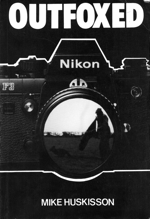
…
-
Books
Love and Anger, 1st and 2nd Editions
05.03.11 | PermalinkLove and Anger, 1st and 2nd Editions (1980?, Westport, CT. USA)
“Animals have rights, interests, desires, and needs equal, within the context of their lives, to those of humans, and we have an obligation to recognize this, and act accordingly. Animal Rights is a philosophical orientation, and a practical necessity if creatures are to be spared the systematic cruelty to which they are currently subjected. But perhaps most importantly, the designation of and agitation for animal rights is part of a revolutionary process aimed at restructuring the major institutions of our society. Indeed, in struggling to change the way humans treat animals, and one another, we work towards nothing less than the transformation of the world.”
– Richard Morgan, from the introduction.
For the last several years, I have been trying to understand why the animal rights movement rode a wave of success in the early 80s, only to fall so sharply by the end of the decade. This inquiry has led me to read old books and magazines, to interview participants from that time period, and even to reading the history of other causes in an attempt to find parallels in their peaks and troughs. I still have not arrived at a conclusive answer to the question, and it appears that many factors played a part in our recession. What is more clear, though, is that one figure played a major role in our rise, only to be quickly forgotten. His name is Richard Morgan, and after working towards civil rights and an end to the war in Vietnam, he took up the cause of animal rights in the late 1970s.
Early figures in the movement speak of Morgan as a pioneer, and his group, Mobilization for Animals, planned some of the largest and most visible demonstrations of the time, drawing thousands of people to multiple locations across the United States. He introduced his organizing model in 1979 with the the first edition of Love and Anger, a book which many people in the fledgling animal rights community cited as their inspiration to start a local group.
Written in a style that blends 70s leftism with 80s self-help jargon, Love and Anger can, at times, be a frustrating read. Morgan certainly has a touch of the arrogant liberalism that repulsed the generation of activists that followed his into the 90s. Scattered throughout the book are unsupportable claims, like American pacifists ending the war in Vietnam with sit ins, and new-agey feel good calls for demonstrations to provide “spiritual nourishment.” Some of the book’s advice is remarkably egalitarian, including calls for work within a group to rotate and for everyone, even supposed leaders, to do “shit work.” But some of the book is strangely authoritarian, with calls for “marshals” at demonstrations to squelch the spontaneous actions of others present. If a reader can get past these snags this book also contains a lot of wisdom.
Written at a time when there was almost no movement to speak of in the United States, the author set out to make a handbook to teach people who had never held a sign before to grow a resistance from scratch. He was concerned about the personal and political development of each new member of this tiny cause, and wanted them to think big. Four years before the first civil disobedience action for animal rights (which took place in New York at the Macy’s Fur Department, not in Sacramento as widely reported elsewhere), Richard Morgan wrote about developing personal courage to face law enforcement and overcome private doubts about organizing ability. He gave practical advice on bringing out large numbers to demonstrations, making literature, contacting media and writing press releases, and other basics that helped make animal rights the breakout issue of the 1980s.
Richard Morgan disappeared from activism in the mid 80s. Attempts to track him down have been fruitless, and even his old friends don’t seem to know what happened to him. But, before he walked out of view, he left us with some powerful advice. I hope young activists will read this book with a critical eye, and consider how these words helped lay the foundation for the movement they participate in today.
…
-
Periodicals
Spectacular Times #10: Animals
03.14.11 | PermalinkSpectacular Times #10: Animals (1980? UK.)
In the late 1970s and early 1980s, Larry Law authored a series of booklets analyzing various issues from a situationist perspective. Consisting of statements by Law, cut and paste articles taken from newspapers at the time, and a little bit of humor, the Animals issue of Spectacular Times reminds of us the deep connections between animal liberation and situationist thought. (Ronnie Lee says that the founding of the ALF was influenced by his appreciation for the Angry Brigade, a British armed revolutionary group whose politics some, Lee included, mark as situationist.)
One article inside concerns the ambivalence and even animosity directed at the animal rights movement from the British left. “Despite all this activity the animal liberation groups are largely ignored by other political groups. Perhaps the politicos are ashamed. In the past five years the animal liberation activists have undertaken more direct action and caused more physical and financial damage to their enemies than the entire British revolutionary left put together. (Including those groups who claim to hold ‘direct action’ as a basic tenet of their philosophy.)” The booklet continues in much the same vain and makes for a great, albeit short read.
…


